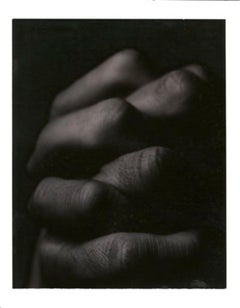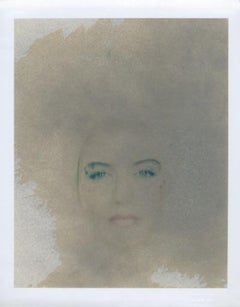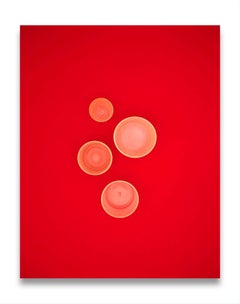Abstract Photography
to
5
112
25
12
8
76
55
6
53
33
13
3
35
Overall Height
to
Overall Width
to
45
44
14
9
7
2
2
1
1
1
1
1
1
1
1
1
1
1
1
1
1
464
5,308
4
6
13
21
31
118
60
106
19
17
14
9
7
75
56
41
35
27
Abstract Photography For Sale
Period: 1960s
Period: 1990s
"Fingers" New York, NY, 1996
By Jose Picayo
Located in Hudson, NY
This photograph is printed on Japanese Paper.
The price is for an unframed photograph.
11" X 14" Edition of 25.
The Robin Rice Gallery is pleased to announce, 25 Years of Polaroi...
Category
1990s Contemporary Abstract Photography
Materials
Photographic Paper
"David", New York, NY, 1996
By Jose Picayo
Located in Hudson, NY
This photograph is printed on Japanese Paper.
The price is for an unframed photograph.
11" X 14" Edition of 25.
The Robin Rice Gallery is pleased to announce, 25 Years of Polaroi...
Category
1990s Contemporary Abstract Photography
Materials
Photographic Paper
"New Woman Magazine, Princess", New York, NY, 1992
By Jose Picayo
Located in Hudson, NY
This photograph is printed on Japanese Paper.
The price is for an unframed photograph.
11" X 14" Edition of 25.
The Robin Rice Gallery is pleased to announce, 25 Years of Polaroi...
Category
1990s Contemporary Abstract Photography
Materials
Photographic Paper
Drawing Air #3A
By Davide Mosconi
Located in Roma, IT
Drawing Air #3A is an original artwork realized by Davide Mosconi in 1996. Photograph printed on paper by phototransfer and magnets.The stamp of the bequest is present. Perfect condi...
Category
1990s Contemporary Abstract Photography
Materials
Photographic Paper
Untitled 110/7
Located in London, GB
C print. Unframed.
Richard Caldicott is most well known for this earlier work series which used Tupperware containers as the subject for his photographs.
As he describes: "Tupperwa...
Category
1990s Minimalist Abstract Photography
Materials
C Print
Untitled 109
Located in London, GB
C print. Unframed.
Richard Caldicott is most well known for this earlier work series which used Tupperware containers as the subject for his photographs.
As he describes : "Tupperw...
Category
1990s Abstract Abstract Photography
Materials
C Print
Times Square in the Rain
Located in Miami, FL
Signature: signed and dated on lower right, numbered on verso, 3 /15 printed later, unframed, other size available .
The genesis of color photography starts with color. Bright, bold...
Category
1990s Abstract Photography
Materials
Photographic Paper
Untitled 110/3
Located in London, GB
C Print. Unframed.
Richard Caldicott is most well known for this earlier work series which used Tupperware containers as the subject for his photographs. This work is edition 6 of 1...
Category
1990s Abstract Abstract Photography
Materials
C Print
New York City, 1970 - Multiple Exposure by Mitchell Funk - Abstract Photography
Located in Miami, FL
This image is 52 years old and yet still looks cutting-edge beautiful. New York City, 1971 is an image generationsahead of its time. Not just for its creative graphic use of color a...
Category
1960s Abstract Geometric Abstract Photography
Materials
Archival Paper, Archival Pigment, Archival Ink
Brooklyn Bridge and Old Man
Located in Miami, FL
Brooklyn Bridge and Old Man was done in 1969 decades before digital. the Artist uses exactor razor blades to scratch out color gel and then assembles them all together on a 35mm sli...
Category
1960s Abstract Geometric Abstract Photography
Materials
Photographic Paper
42nd St. Diamond Stud
Located in Miami, FL
Adult movie marquees of old 42nd street in 1970. Double header, ABC's of Marriage and Diamond Stud
Signature: Signed and dated on lower right, numbered on verso Edition 2 of 15. U...
Category
1960s Abstract Abstract Photography
Materials
Photographic Film, Inkjet
Abstract Brooklyn Bridge, Camera 35 Cover, 1973
Located in Miami, FL
Shipping should be around $100. In-camera multiple exposure with colored gels produces a complex semi-abstract image generation ahead of its time. Created in 1970. Camera 35 Cove...
Category
1960s Abstract Abstract Photography
Materials
Photographic Paper
Abstract Church - Manipulated Photography
Located in Miami, FL
This ia an early example of photo manipulation. Photographer put a match to the 35mm emulsion to the burned bubble effect and then sandwiched it with colored gels in a double exposur...
Category
1960s Expressionist Abstract Photography
Materials
Photographic Paper, Archival Ink, Archival Paper, Archival Pigment
Glen Canyon
By Brett Weston
Located in Carmel-by-the-Sea, CA
Signed and dated on the front of the mount. Mounted on Crescent Board. Printed in the 1960s.
Category
1960s Modern Abstract Photography
Materials
Silver Gelatin
Diptychon # 31
Located in Kansas City, MO
Diptychon # 31
Color photograph
Signed, numbered, dated and titled by hand
Edition: 12 + III
COA provided
Thomas Florschuetz (German, born 1960) recently emigrated from East Germany...
Category
1990s Abstract Abstract Photography
Materials
Archival Ink, Archival Paper, C Print
Diptychon #32
Located in Kansas City, MO
Diptychon #32
Color photograph
Signed, numbered, dated and titled by hand
Edition: 12 + III
COA provided
Thomas Florschuetz (German, born 1960) recently emigrated from East Germany,...
Category
1990s Contemporary Abstract Photography
Materials
Archival Ink, Archival Paper, C Print
Vintage Abstract Expressionist Hyman Bloom Photo Collage Assemblage Photograph
Located in Surfside, FL
This is a unique original collage, decoupage style of Jiri Kolar, This is an exceptional artwork which was part of a collaboration between Hyman Bloom and fellow artist and his very good friend Martin Sumers. This is pencil signed by Martin Sumers.
Provenance: Acquired from the Sumers estate collection.
Hyman Bloom (March 29, 1913 – August 26, 2009) was a Latvian-born American painter. His work was influenced by his Jewish heritage and Eastern religions as well as by artists including Altdorfer, Grünewald, Caravaggio, Rembrandt, Blake, Bresdin, James Ensor and Chaim Soutine. He first came to prominence when his work was included in the 1942 Museum of Modern Art exhibition "Americans 1942 -- 18 Artists from 9 States". MoMA purchased 2 paintings from the exhibition and Time magazine singled him out as a "striking discovery" in their exhibition review.
His work was selected for both the 1948 and 1950 Venice Biennale exhibitions and his 1954 retrospective traveled from Boston's Institute of Contemporary Art to the Albright Gallery and the de Young Museum before closing out at The Whitney Museum of American Art in 1955. In a 1954 interview with Yale art professor Bernard Chaet, Willem de Kooning indicated that he and Jackson Pollock both considered Bloom to be “America’s first abstract expressionist”, a label that Bloom would disavow. Starting in the mid 1950s his work began to shift more towards works on paper and he exclusively focused on drawing throughout the 1960s, returning to painting in 1971. He continued both drawing and painting until his death in 2009 at the age of 9
Hyman Bloom (né Melamed) was born into an orthodox Jewish family in the tiny Jewish village of Brunavišķi in what is now Latvia, then part of the Russian Empire
At a young age Bloom planned to become a rabbi, but his family could not find a suitable teacher. In the eighth grade he received a scholarship to a program for gifted high school students at the Museum of Fine Arts. He attended the Boston High School of Commerce, which was near the museum. He also took art classes at the West End Community Center, a settlement house. The classes were taught by Harold Zimmerman, a student at the School of the Museum of Fine Arts, who also taught the young Jack Levine at another settlement house in Roxbury. When Bloom was fifteen, he and Levine began studying with a well-known Harvard art professor, Denman Ross, who rented a studio for the purpose and paid the boys a weekly stipend to enable them to continue their studies rather than take jobs to support their families.
He took Bloom and Levine on a field trip to the Museum of Modern Art in New York, where Bloom was impressed by the work of Rouault and Soutine and began experimenting with their expressive painting styles.
In the 1930s Bloom worked sporadically for the Public Works of Art Project and the Federal Art Project (WPA), He shared a studio in the South End with Levine and another artist, Betty Chase. It was during this period that he developed a lifelong interest in Eastern philosophy and music, and in Theosophy.
He first received national attention in 1942 when thirteen of his paintings were included in the Museum of Modern Art (MoMA) exhibition Americans 1942: 18 Artists from 9 States, curated by Dorothy Miller. MoMA purchased two of his paintings from that exhibition, and he was featured in Time magazine. The titles of his paintings in the exhibition reflect some of his recurring themes. Two were titled The Synagogue, another, Jew with the Torah; Bloom was actually criticized by one reviewer for including "stereotypical" Jewish images. He also had two paintings titled The Christmas Tree, and another titled The Chandelier, both subjects he returned to repeatedly. Another, Skeleton (c. 1936), was followed by a series of cadaver paintings in the forties, and The Fish (c. 1936) was one of many paintings and drawings of fish he created over the course of his career.
Bloom was associated at first with the growing Abstract Expressionist movement. Willem de Kooning and Jackson Pollock, who first saw Bloom's work at the MoMA exhibition, considered Bloom "the first Abstract Expressionist artist in America." In 1950 he was chosen, along with the likes of de Kooning, Pollock, and Arshile Gorky, to represent the United States at the Venice Biennale. That same year Elaine de Kooning wrote about Bloom in ARTnews, noting that in paintings such as The Harpies, his work approached total abstraction: "the whole impact is carried in the boiling action of the pigment". In 1951 Thomas B. Hess reproduced Bloom's Archaeological Treasure in his first book, Abstract Painting: Background and American Phase, along with works by Picasso, Pollock, and others. Both de Kooning and Hess remarked on Bloom's expressive paint handling, a key characteristic of Abstract Expressionist painting.
As abstract expressionism dominated the American art world, Bloom became disenchanted with it, calling it "emotional catharsis, with no intellectual basis." In addition, instead of moving to New York to pursue his career, he opted to stay in Boston. As a result he fell out of favor with critics and never achieved the kind of fame that Pollock and others did. He disliked self-promotion and never placed much value on critical acclaim.
Many of Bloom's paintings feature rabbis, usually holding the Torah. According to Bloom, his intentions were more artistic than religious. He began questioning his Jewish faith early in life, and painted rabbis, he claimed, because that was what he knew. Over the course of his career he produced dozens of paintings of rabbis...
Category
1990s Modern Abstract Photography
Materials
Photographic Paper, Paper
Agava, Paradise Park
By Brett Weston
Located in Carmel-by-the-Sea, CA
Signed on the front of the mount. Printed circa 1991 by Brett Weston.
Category
1990s Abstract Photography
Materials
Silver Gelatin
Tempus Fugit, Deerfield Beach, Florida
Located in Carmel-by-the-Sea, CA
Signed, numbered and dated on front of the mount. Signed, dated, numbered and titled with artist's copyright stamp on back of the mount. This piece is completely sold out and now av...
Category
1990s Abstract Photography
Materials
Silver Gelatin
Poet's House
Located in Carmel-by-the-Sea, CA
Signed on the front. Made in the darkroom by Jerry Uelsmann using up to seven enlarger. Contact gallery for prices and available sizes as our inventory is subject to change.
Category
1990s Abstract Photography
Materials
Silver Gelatin
"Violin", 1997
By Steve Miller
Located in Hudson, NY
While all photography arrests motion, it is only the X-ray that allows us to climb inside a particular moment and subject and parse the structure of its beauty from within. Miller’s ...
Category
1990s Contemporary Abstract Photography
Materials
Archival Paper
Recently Viewed
View AllMore Ways To Browse
1918 Dress
19th Century French Female Portraits
Miami Beach Art Deco
Mod Life
Original Mexican Posters
Paintings Pre 1900
Sculpture Nude Black Male
American Vintage Football
Andy Warhol Gay
Architect Drawing Tools
Artist Russell Wood
Barber Sign
Baseball Player
Invader Country Life
Keith Haring 1981
Late 1800s Oil Painting
Led Neon
Male Nude Modern Sculpture





